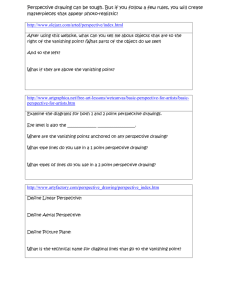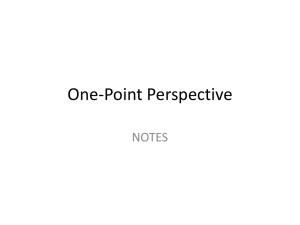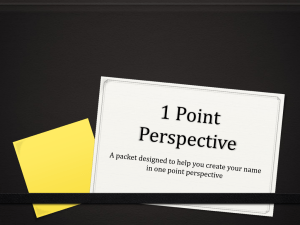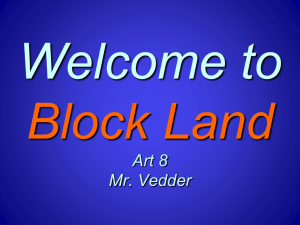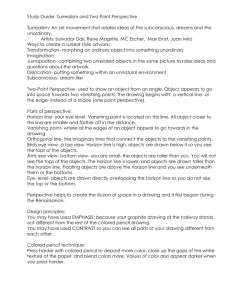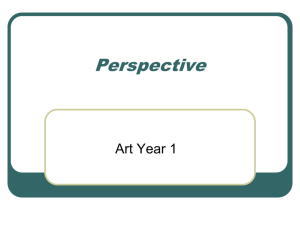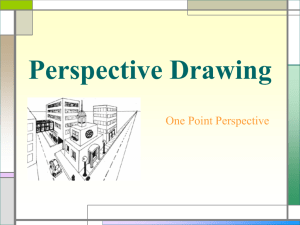Drawing Perspective
advertisement
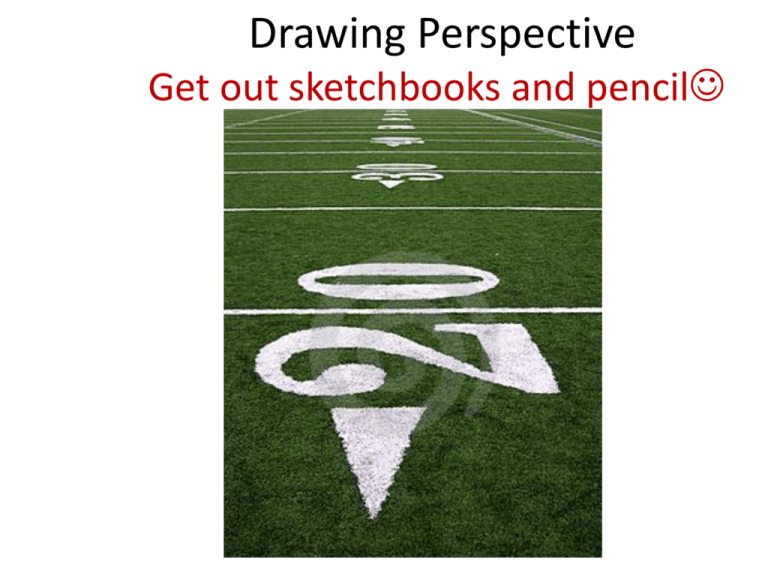
Drawing Perspective Get out sketchbooks and pencil Key Terms – Write these terms on a new page in your sketchbook. We will BRIEFLY define as we cover it. • Perspective • Horizon Line • Vanishing Point • One-point perspective • Two-point perspective • Atmospheric/Aerial Perspective (When viewing pictures, hold your viewfinder up and see what is above and below the middle line. Determine the position of your HL and draw it in immediately) Perspective • Depicts foreground, middle ground and background to indicate deep space. Horizon Line • Eye level. • Where the earth meets the sky. • The vanishing point sits on the horizon line. Vanishing Point • A point in a perspective drawing to which parallel lines of objects appear to converge. • The number and placement of the vanishing points determines which perspective technique is being used. • The concept was first used by Renaissance artists. Question: What is the subject matter, and who painted this picture? Do you know where is it located? • Sometimes the vanishing point is not visible along the horizon line. One-point PerspectiveWho came up with the system for linear perspective? • One vanishing point is typically used for roads, railway tracks, or buildings viewed so that the front is directly facing the viewer. • All parallel lines converge at a single point on the horizon or eye level line. Perugino “Christ Handing Keys to St. Peter” Atmospheric Perspective • A technique in which an illusion of depth is created by painting more distant objects with less clarity, and with a lighter tone. Discovered by___________. Which two types of perspective would be used in this picture? This is so very easy—give it a try! Start with the horizon line, then establish a vanishing point on the horizon line, next draw the front of each box. Put your ruler on the vanishing point and draw converging lines from each box to the vanishing point. Close the sides of the boxes with a vertical line. Draw rectangle 8 across x 9 down Erase the guidelines Put a dot in center horizontally but above center vertically Draw the outline of the armchair, then cushions and seams. Notice where the cushions intersect with the guidelines. Measure and draw light guidelines to the center dot—make sure to measure equal distances from the sides of the box. This is relatively easy because there is only one vanishing point. Make sure all converging lines meet at the vanishing point, then, draw your horizontal lines further apart near the front and closer together at the back of the picture so that the tiles seem to disappear. http://www.youtube.com/watch?v=7ZYBWAifEs 1 point room http://www.youtube.com/watch?v=hJq7uVhYIY 8&feature=related 1 point road/city On your tablets, or on the photocopies, find the horizon line and the vanishing point! Are you already skilled at perspective? If so, you will be able to go ahead of the class… Take a drawing board, ruler and pencil with you. Find a one point perspective view of a hall in this building If you are particularly skilled, you may take on a 2 point perspective angle. Make a light pencil drawing first, ensuring that ALL lines are correct. Next, shade with a pencil or use color pencils to make a complete drawing. You must have a mat ready drawing when you are finished. With your stylus, draw a cube inside the square on the right. Construct the stool inside the cube, then erase the extra lines. That is all there is to it! Roads—we use perspective so often when roads seem to disappear. Let’s try a few. 1. 2. 3. 4. Draw the panoramic rectangle first. Establish the horizon line, now find the vanishing point. Begin the road close to the right bottom side of the page. Curve it back to touch the vanishing point. Do the same with the road on the left side of the page. 5. Construct the fence. The vertical posts are further apart at the front of the page, and closer together in the back.They look like the turn a solid white when they get very close together. http://www.youtube.com/watch?v=wEpVMop B6l8&feature=related Curving road Two-point Perspective • Two-point perspective can be used to draw the same objects as one-point perspective, rotated: looking at the corner of a house, or looking at two forked roads shrink into the distance, for example. One point on the horizon line represents one set of parallel lines, the other point on the horizon line represents the other set of lines. • Looking at a house from the corner, one wall would recede towards one vanishing point, the other wall would recede towards the opposite vanishing point. http://www.youtube.com/watch?v=c3Nv3SrtQu k&feature=related Mid-Level View • When the horizon line crosses through the middle of something, the lines angle up and down. • http://www.youtube.com/watch?v=Dsa4r3oM6 Ws&feature=related • (to somewhere over the rainbow) Worm’s-Eye View • Lines extend ABOVE the Horizon Line • Lines angle UP Bird’s-Eye View • Lines extend BELOW horizon line • Lines angle DOWN Use a colored pencil and ruler to find the vanishing point and establish converging lines that lead to the vanishing point (which is on the horizon line). Construct verticals parallel to the side of the paper.

